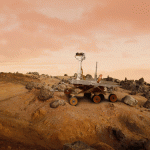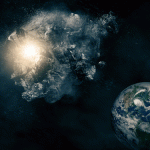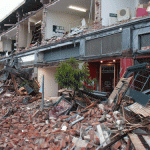
SN 1987A was the closest supernova to Earth in 400 years. Credit: NASA / ESA / P. Challis and R. Kirshner (Harvard-Smithsonian Center for Astrophysics).
Astronomers say there is no threatening star that could cause a supernovae explosion near Earth, much less in December 2012.
The Mayan Long Count Calendar will end on December 20, 2012- which is now less than a year away. This has sparked a number of doomsday scenarios, including a supernova harming life on Earth or a burst of gamma rays aimed straight at our planet.
The immense amount of energy produced by one of these explosions is equivalent to the total energy that our Sun will produce in its lifetime. However, given the time between supernovae and the distances involved, astronomers say there aren’t any stars close enough to harm life on Earth.
If a star did go supernova, any nearby planet containing life would indeed experience problems. The X-rays and gamma rays would damage the ozone layer, allowing more UV light to reach the planet’s surface.
At some wavelengths, just a 10 per cent increase in ground level UV can be lethal to some organisms, such as the phytoplankton on the surface of Earth’s oceans, which form the basis of the marine food chain and our planet’s oxygen production.
Francis Reddy from NASA’s Goddard Space Flight Center wrote that astronomers have estimated that, on average, one or two stars go supernovae per century in our galaxy. But for our ozone layer to be damaged, he explained, the blast would have to occur less than 50 light years away from Earth and all of the stars capable of going supernova are much further away.
The closest supernova, named SN 1987A, occurred in the Large Magellanic cloud, a small galaxy which orbits the Milky Way. Its light reached us in 1987 and it is the closest supernova in modern times.
Reddy has also outlined the likelihood of another explosive theory, this time involving gamma ray bursts, which are often associated with supernovae. Some of the matter falling towards a nascent black hole can be accelerated into a powerful particle jet that can drill its way through the star before its outermost layers have begun to collapse.
These bursts are powerful enough to be seen across billions of light years and occur almost daily. These could affect Earth in the same way as a supernova and over a much greater distance, Reddy said, but only if they are pointed directly at us.
If a particle jet is directed at Earth, orbiting satellites detect a burst of gamma rays. Astronomers have estimated that a gamma-ray burst could affect our planet from up to 10,000 light years away, with each separated by approximately 15 million years, on average. However, the closest burst, GRB 031203, occurred 1.3 billion light-years away.
Source: NASA/Goddard Space Flight Center






